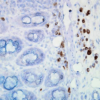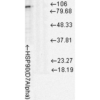Anti-Hsp90α Antibody (11102)
$479.00
| Host | Quantity | Applications | Species Reactivity | Data Sheet | |
|---|---|---|---|---|---|
| Mouse | 100ug | WB,IHC,IP,ELISA,AM | Human, Mouse, Rat, Rabbit, Bovine, Porcine, Chicken |  |
SKU: 11102
Categories: Antibody Products, Heat Shock and Stress Protein Antibodies, Products
Overview
Product Name Anti-Hsp90α Antibody (11102)
Description Anti-Hsp90α Mouse Monoclonal Antibody
Target Hsp90α
Species Reactivity Human, Mouse, Rat, Rabbit, Bovine, Porcine, Chicken
Applications WB,IHC,IP,ELISA,AM
Host Mouse
Clonality Monoclonal
Clone ID D7alpha
Isotype IgG1
Immunogen Full-length Hsp90 purified from chicken brain
Properties
Form Liquid
Concentration Lot Specific
Formulation PBS, pH 7.4.
Buffer Formulation Phosphate Buffered Saline
Buffer pH pH 7.4
Format Purified
Purification Purified by Protein G affinity chromatography
Specificity Information
Specificity This antibody recognizes human, mouse, rat, rabbit, bovine, porcine, and chicken Hsp90alpha (90 kDa).
Target Name Heat shock protein HSP 90-α
Target ID Hsp90α
Uniprot ID P11501
Gene Name HSP90AA1
Gene ID 9031
Accession Number NP_001103255.1
Sequence Location Cytoplasm, Melanosome
Biological Function Molecular chaperone that promotes the maturation, structural maintenance and proper regulation of specific target proteins involved for instance in cell cycle control and signal transduction. Undergoes a functional cycle that is linked to its ATPase activity which is essential for its chaperone activity. This cycle probably induces conformational changes in the client proteins, thereby causing their activation. Interacts dynamically with various co-chaperones that modulate its substrate rUniProtKB:P07900}.
Research Areas Heat Shock& Stress Proteins
Background Hsp90 and the 94 kDa glucose-regulated protein, Grp94, are major molecular chapeones of the cytosol and endoplasmic reticulum. In mammalian cells, there are at least two Hsp90 isoforms, Hsp90alpha and Hsp90beta, which are encoded by separate genes. All known members of the Hsp90 family are highly conserved, especially in the N-terminal and C-terminal regions. In the absence of stress, Hsp90 is an essential component of cellular processes such as hormone signaling and cell cycle control. Several regulatory proteins such as steroid receptors, cell cycle kinases and p53 have been identified as substrates of Hsp90.
Application Images




Description Immunohistochemistry analysis using Mouse Anti-Hsp90 Monoclonal Antibody, Clone D7alpha (11102). Tissue: colon carcinoma. Species: Human. Fixation: Formalin. Primary Antibody: Mouse Anti-Hsp90 Monoclonal Antibody (11102) at 1:100000 for 12 hours at 4°C. Secondary Antibody: Biotin Goat Anti-Mouse at 1:2000 for 1 hour at RT. Counterstain: Mayer Hematoxylin (purple/blue) nuclear stain at 200 µl for 2 minutes at RT. Magnification: 40x. This image was produced using an amplifying IHC wash buffer. The antibody has therefore been diluted more than is recommended for other applications.

Description Immunohistochemistry analysis using Mouse Anti-Hsp90 Monoclonal Antibody, Clone D7alpha (11102). Tissue: inflamed colon. Species: Mouse. Fixation: Formalin. Primary Antibody: Mouse Anti-Hsp90 Monoclonal Antibody (11102) at 1:100000 for 12 hours at 4°C. Secondary Antibody: Biotin Goat Anti-Mouse at 1:2000 for 1 hour at RT. Counterstain: Mayer Hematoxylin (purple/blue) nuclear stain at 200 µl for 2 minutes at RT. Localization: Inflammatory cells. Magnification: 40x. Inflammatory cells. This image was produced using an amplifying IHC wash buffer. The antibody has therefore been diluted more than is recommended for other applications.

Description Western Blot analysis of Rat cell lysates showing detection of Hsp90 protein using Mouse Anti-Hsp90 Monoclonal Antibody, Clone D7Alpha (11102). Load: 15 µg. Block: 1.5% BSA for 30 minutes at RT. Primary Antibody: Mouse Anti-Hsp90 Monoclonal Antibody (11102) at 1:1000 for 2 hours at RT. Secondary Antibody: Sheep Anti-Mouse IgG: HRP for 1 hour at RT.
Handling
Storage This antibody is stable for at least one (1) year at -20°C.
Dilution Instructions Dilute in PBS or medium which is identical to that used in the assay system.
Application Instructions Immunoblotting: use at 1-5ug/mL. A band of ~90 kDa is detected.
Immunoprecipitation: 5ug on 20ul Protein A-Sepharose + 100ul sample.
These are recommended concentrations. User should determine optimal concentrations for their application.
Positive control: Heat-shocked HeLa cell lysate.
Immunoprecipitation: 5ug on 20ul Protein A-Sepharose + 100ul sample.
These are recommended concentrations. User should determine optimal concentrations for their application.
Positive control: Heat-shocked HeLa cell lysate.
References & Data Sheet
References Schuh S et al. 1985 J Biol Chem 260: 14292-14296
Sullivan WP et al. 1985 Biochemistry 24: 4214-4222.
Sullivan WP et al. 1985 Biochemistry 24: 4214-4222.
Data Sheet  Download PDF Data Sheet
Download PDF Data Sheet
 Download PDF Data Sheet
Download PDF Data Sheet






